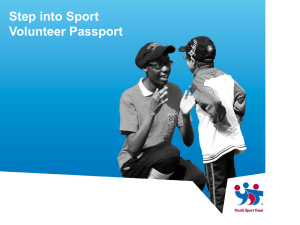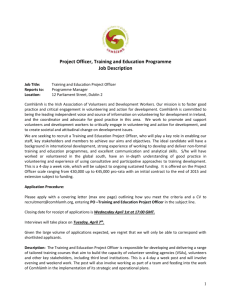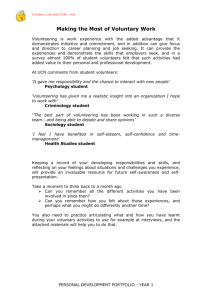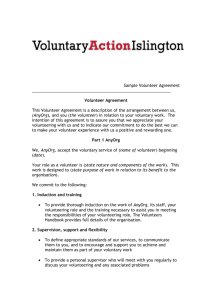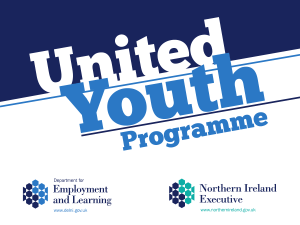public health and localism cabinet panel
advertisement
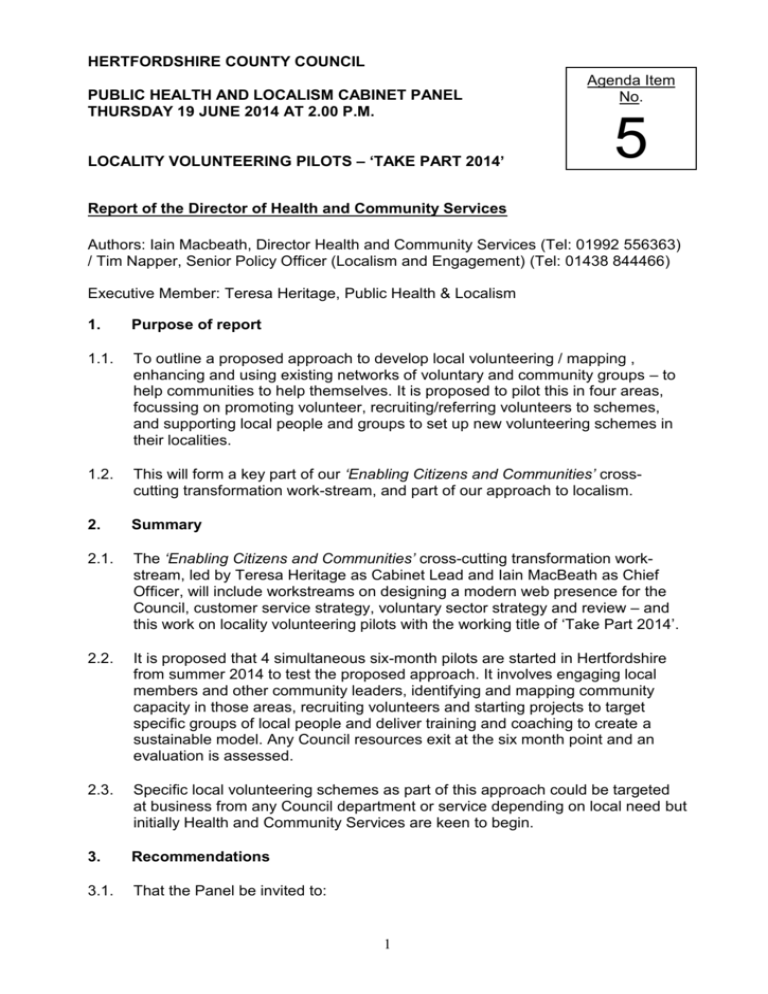
HERTFORDSHIRE COUNTY COUNCIL PUBLIC HEALTH AND LOCALISM CABINET PANEL THURSDAY 19 JUNE 2014 AT 2.00 P.M. LOCALITY VOLUNTEERING PILOTS – ‘TAKE PART 2014’ Agenda Item No. 5 Report of the Director of Health and Community Services Authors: Iain Macbeath, Director Health and Community Services (Tel: 01992 556363) / Tim Napper, Senior Policy Officer (Localism and Engagement) (Tel: 01438 844466) Executive Member: Teresa Heritage, Public Health & Localism 1. Purpose of report 1.1. To outline a proposed approach to develop local volunteering / mapping , enhancing and using existing networks of voluntary and community groups – to help communities to help themselves. It is proposed to pilot this in four areas, focussing on promoting volunteer, recruiting/referring volunteers to schemes, and supporting local people and groups to set up new volunteering schemes in their localities. 1.2. This will form a key part of our ‘Enabling Citizens and Communities’ crosscutting transformation work-stream, and part of our approach to localism. 2. Summary 2.1. The ‘Enabling Citizens and Communities’ cross-cutting transformation workstream, led by Teresa Heritage as Cabinet Lead and Iain MacBeath as Chief Officer, will include workstreams on designing a modern web presence for the Council, customer service strategy, voluntary sector strategy and review – and this work on locality volunteering pilots with the working title of ‘Take Part 2014’. 2.2. It is proposed that 4 simultaneous six-month pilots are started in Hertfordshire from summer 2014 to test the proposed approach. It involves engaging local members and other community leaders, identifying and mapping community capacity in those areas, recruiting volunteers and starting projects to target specific groups of local people and deliver training and coaching to create a sustainable model. Any Council resources exit at the six month point and an evaluation is assessed. 2.3. Specific local volunteering schemes as part of this approach could be targeted at business from any Council department or service depending on local need but initially Health and Community Services are keen to begin. 3. Recommendations 3.1. That the Panel be invited to: 1 3.1.1. Endorse the approach to developing this scheme contained in this report. 3.1.2. Endorse the governance structure set out below. 3.1.3. Endorse the proposed generic action plan set out below, which would be customised for every local area with partners and the community. 4. Background 4.1. 4.2. 4.3. This project will pilot a new way of supporting our communities, initially in four pilot localities, to map their current community assets and find local solutions to local problems. It is intended that these will launch in each locality in September 2014, with preparatory work being undertaken over summer. The aim is to develop activities and networks in order to: Deliver preventative activities in the community that defer, reduce or remove the need for statutory services and help communities to understand how they can help themselves; Deliver significant financial savings for the Council in the medium to long term. The four electoral divisions from which smaller localities will be chosen to pilot this approach are: North Herts Rural (Tony Hunter, Con) Waltham Cross (Dee Hart, Con) Vicarage Holywell (Nigel Bell, Lab) Hemel Hempstead St Pauls (Ron Tindall, Lib Dem) The project will develop recruitment pathways for people to take part and will aim for sustainability by establishing ‘lead volunteers’ in localities. It is critical that this project supports and enhances existing local volunteering and community initiatives alongside the work of local partners including Councils for the Voluntary Sector (CVSs), Volunteer Centres, Districts and Parish Councils. If the pilot evaluation proves successful, the approach will be extended to other areas of the county. Why is this project needed? Need to reduce financial pressures from demand for statutory services; To support delivery of the Council’s approach to localism, in order to support and enable communities to identify and solve local problems themselves; Limited co-ordinated working: professionals, residents and communities could be better informed about what help is available locally, how to access it and how to get involved, thus building local resilience and responsibility; Volunteering and ‘getting involved’ has measurable health and wellbeing benefits for the volunteers as well as the recipients of such schemes; Opportunity for services to be more reactive and responsive to local needs. 2 Expected Outcomes Council professionals and communities working together to reduce demand for statutory services and create savings for HCC and the public purse; More people willing and able to volunteer and a developing network of volunteers, including lead volunteers; Better connection to and awareness of their neighbours (reducing social isolation) and neighbourhood resources; Improved health and wellbeing through volunteering and staying active. Further information on service specific outcomes is in Appendix B and on the health and wellbeing benefits of volunteering is contained in Appendix C of this report. We will work with partners to develop methods to evaluate these outcomes in each specific locality. Methods could include questionnaires or focus groups with volunteers to find out about their experiences, and working with Volunteer Centres and Councils for the Voluntary Sector to identify whether there has been an increase in enquiries/referrals from people wanting to volunteer Areas of focus 5. Fostering a culture of self-help and communities supporting one another Enabling volunteers to access training, learning and opportunities Building community capacity through joining up, coordinating and facilitating voluntary effort that supports the work of the County Council, districts, health and community initiatives; Recruiting volunteers, especially for / from vulnerable and health risk groups – e.g. new retirees lacking stimulation, people with long term conditions, new graduates struggling to reach their potential, former professionals keen to keep occupied. Pilot Areas – Reasons for Selection 5.1. The four proposed pilot areas have been selected in order to provide a variety of locations in which to pilot this work. The four areas contrast one another in a range of ways, including: urban/rural character, differing districts, varying levels of deprivation across different measures, differences in whether the population is more or less willing to volunteer already, and differing population profiles. 5.2. It is hoped that by piloting this work in contrasting areas, the project team can learn lessons as to what works in differing contexts when it comes to supporting and encouraging volunteering. It is hoped that the pilots will help inform the role 3 out of this initiative across the county, by assisting in the development of different tools and approaches for supporting volunteering. 5.3. It is envisaged that the pilots will focus on one Ward within each of the proposed pilot Division areas. The final area(s) chosen, within the Ward, will depend on the size and partnership complexity within each pilot area. 5.4. Data relating to the four proposed pilot areas is contained within the accompanying background document. 6. Project Delivery 6.1. The project lead organisation will be Hertfordshire County Council. However, partnership working will be critical to success. We will work with elected Members and partners in the locality areas from the outset (including district/borough councils, GPs and Clinical Commissioning Groups (CCGs), the Police and Crime Commissioner, Herts Help, CVSs, Volunteer Centres, Town and Parish Councils, and local community groups). Within HCC many services already work with volunteers in various ways and could support the recruitment of local volunteers through existing channels and networks. County Council departmental locality teams and Public Health will be key early partners, as well as other services depending on how the projects evolve and develop in each locality. 6.2. The pilot areas will be supported by a dedicated Council resource for a timelimited period (six months) to work towards the project outcomes. This will be in four main phases, summarised below and expended on in greater detail in the final section of this report. It is intended to formally launch the first four pilots in September 2014, with preparation work to be undertaken over the summer. Phase 1: Engagement and mapping work (months 1-2) Phase 2: Developing the volunteering infrastructure (months 2-4) Phase 3: Volunteers / networks start to support specific groups (months 46) Phase 4: Evaluate sustainability, learn lessons, consider future (month 6) Our Offer 6.3. 6.4. The specific support offered in each pilot area is likely to vary between localities and will need to be identified in collaboration with partners, based on what is already in place locally and what support is needed to develop new schemes or strengthen existing ones. Any support we offer to the pilot areas will last for up to six months and could include: Volunteering training / mentoring / coaching Communications, publicity and community engagement activities Improving referral processes for those interested in volunteering Support to develop a network of local volunteers and voluntary activities Early engagement with local partners will be vital to understand what already exists locally, what is missing, and who would be best placed to deliver 4 additional support, including what the resourcing requirements will be for this and from where this could be sourced. One-off funds have been set aside to support delivery of this through the best-placed partners, as identified locally. 7. Resources: existing and additional 7.1. The majority of the six month support plan would use existing county officers from within HCS’ Community Wellbeing Team, which leads countywide on volunteering and engages with many Voluntary and Community sector partners, from the Corporate Policy Team, from reallocated existing voluntary sector contract spend (e.g. HertsHelp) and from existing departmental locality team staffing. It may be necessary to supplement one or more of these areas temporarily if it is found that more resource is required to meet timescales and achieve sustainability after the six month period. 7.2. The pilots will also look to work with Volunteering Centres, Councils for the Voluntary Sector and other VCS infrastructure providers in each locality, along with other local partners such as district councils and the CCGs. These organisations already deliver support to VCS groups and to volunteers within their areas and it will be important to work collaboratively with them to develop enhanced support for volunteering and to promote new schemes. It may be necessary to commission these infrastructure organisations to undertake specific pieces of work, depending on the nature of the working relationship with them and the specific roles these organisations take on within each pilot area, 7.3. Additional resource (for example, a small budget that can be used to commission work from local partners or other agencies) may also be required to develop the support outlined above. A one-off budget of £200,000 has been set aside for small grants of between £1,000 - £10,000 for voluntary or community groups. 8. Extending across the County 8.1. The pilots will consist of intensive support for up to six months. We will then evaluate success and sustainability and consider how the approach can be extended to other areas, based on the outcomes outlined in section 4.3 above and specific learning from each pilot area as to what approaches have been more or less successful. 8.2. Possible options could include: 8.3. Commissioning local CVSs or other appropriate partners to transfer learning and knowledge to another area within their district or a different district Working with local Members to explore whether they could support sharing learning through their local networks and contacts Working with relevant HCC teams based in new localities to change the way they work in order to deliver this new approach We are aware of a number of related workstreams – for example Public Health work with districts, Health and Wellbeing priorities, Highways pilots and CCG-led projects – which we will need to investigate further and explore opportunities for 5 joining up. 9. Governance and Reporting 9.1. The ‘Enabling Citizens and Communities’ cross-cutting transformation workstream, led by Teresa Heritage as Cabinet Lead and Iain MacBeath as Chief Officer, will drive the work of a sub-group overseeing the four pilot areas. 9.2. Overall, governance will be designed to avoid creating a hierarchical structure which local groups and residents feel they have to ‘report up’ to, whilst at the same time putting in place support structures to bring together and support local voluntary activities. 9.3. At the end of the first tranche of pilots in approximately nine months’ time, an update paper will be brought back to this Panel with an update. 10. Financial Implications 10.1. Resources will largely be provided from within existing teams. As noted above, a one-off budget of £200,000 has been set aside for small grants of between £1,000 - £10,000 for voluntary or community groups 6 11. Project Risks Risk Proposed Mitigation Work with local county councillor to identify key partners Engage key partners at an early stage in planning the project for that locality Incorporate key partners’ aims and ambitions into pilot locality projects Work with local Members (all tiers of local government) and key partners to advertise the initiative through existing communications channels Utilise the County Council’s communications channels Use pilots to identify practical examples and stories to help engage residents in other pilot areas and future project areas. Perception from local residents and/or local partners that there are too many simultaneous initiatives seeking to work with volunteers, from both the County Council and other partners. There is a risk that this may lead to disengagement or to many projects seeking to work with the same groups of people, without properly joining up. Map projects already working with and those seeking to work with volunteers in each locality. Work with local partners and Members to do this and to look for joint projects where possible/appropriate. Develop promotional materials to encourage more people to volunteer Develop a range of schemes that meet the needs of different people (e.g. those who can only volunteer at evenings or weekends, those who cannot commit to regular volunteering but may be able to support oneoff events), enabling a wider range of people to participate. iii. Engagement and relationship building will take longer than anticipated: this will reduce what can be achieved in terms of measurable outcomes in six months Identify achievable short-term outcomes to be delivered during six months Plan for handover of projects to ‘business as usual’ (e.g. via social work locality teams and Herts Help) to continue work of the pilots after the six months Work with the voluntary sector in each locality to explore ways to sustain the initiatives. Engage the local county Member as an additional longer term link into HCC i. Lack of engagement from local partners: seen as too top down and not a local initiative ii. Lack of interest from local residents: seen as replacing services, not complementary 7 iv. Size of pilot areas restrict involvement and learning: if the ambition is that this approach is extended to all areas of the county, this may not be the best scale to test it and get buy in from partners who operate at a wider level Engage partners at an early stage to understand their priorities and to look for ways to deliver mutual benefits to all involved through the pilots, thus securing partners’ buy-in Identify a specific ward within each area on which to focus Deliver pilots in varying localities in order to gather learning from differing contexts v. Having sufficient time and resource to scale up to other areas Engage relevant HCC teams operating in localities (e.g. social work locality teams) at an early stage to plan how to ‘mainstream’ this approach Engage with partners (e.g. CCGs, PCC, District Councils) to share and support the transfer of learning to other localities Engage key partners with a countywide brief – e.g. Herts Help – who can help transfer learning to other areas For all of the above risks, the pilots will need to reflect on to what extent these risks were realised during delivery in each locality and document what approaches were more or less successful, as part of the lessons learnt process. 8 APPENDIX A - OUTLINE ACTION PLAN: Timescales, Activities, Resources, Outputs/Outcomes (for detailed outcomes, see below) When Activities Preparation Phase Initial engagement with local members & key local partners in each locality Identify smaller ward areas on which to focus in each of the four pilot divisions Preparing and gathering all available, relevant data for pilot areas – e.g. public health electoral division profiles Develop toolkit – e.g. key messages, data, outcomes required – for officers to use when working with localities Identifying community leaders with local member, District/Borough Council and CVS/Volunteering Centre, including agreeing any relevant funding required Find and map local resources / groups Agree and map scope of local project, including known local needs, specific outcomes and overall vision Engage with partners and prepare project plan Engage with local health and social care teams, GPs, CCG and other local partners Agree communications and reporting strategy Hold local launch event(s) to jointly map existing activities and community assets and to plan local activities with the community in each area Phase 1 Weeks 1-4 Desired outcomes for phase 1: 1. Local resources, services, groups and current volunteering infrastructure mapped 2. Local residents and partners know about the project, how they can get involved and why they should 3. Successful engagement events and residents who want to get more involved 4. Volunteers and volunteer leaders identified Phase 2 Weeks 4-12 Developing volunteer infrastructure: Evaluate existing volunteer infrastructure, including local assets and resources (e.g. community venues) Developing local network of volunteers and voluntary activity to share ideas and plan joint ventures Identify training needs and who can deliver training/coaching/mentoring Identify and evaluate communications and publicity channels that publicise volunteering and local issues Agree sustainable pathways for new volunteers Agree pathways for community and service referrals Identify and train lead volunteers Develop action plan for improving/strengthening/ joining up local infrastructure and volunteering opportunities Page 9 of 12 Desired outcomes for phase 2: 1. Gaps identified where volunteers can add value – e.g. befriending, trips to GP, visiting neighbours, supporting youth clubs 2. Training needs identified 3. Volunteers and volunteer leaders recruited and trained 4. Best methods identified for communicating/publicising volunteering opportunities and local issues/needs 5. Framework to manage, coordinate and access volunteers and volunteering agreed Phase 3 Weeks 9-16 Volunteers support communities and community groups to work towards shared outcomes Developing existing schemes / activities Setting up new services – e.g. informal befriending, home help Better signposting, professional and community awareness HCC services identify how they can support volunteers and community groups to get more involved Desired outcomes for phase 3: 1. Local people know how they can get involved to help their community 2. Volunteer leaders co-ordinating support to statutory and voluntary services 3. Public service professionals engaging with volunteers: HCC services and the community working together to make best use of local resources 4. Volunteers developing as a local network 5. Volunteers supporting their communities e.g. online shopping scheme, supported GP visits, befriending, etc Phase 4 Weeks 16-24 Evaluate sustainability Consider what further support volunteer leaders require to help them continue in this role Commitment of local communities and partners Agree timescales for following up and assessing progress Gather together lessons learned and present findings to project board and partners Consider how learning /new approaches can be transferred to other areas of the county Desired outcomes for phase 4: 1. Local statutory services are being utilised appropriately; non emergent needs being met by informal activity / volunteers 2. Communities and voluntary organisations willing to continue to lead 3. Different commissioning opportunities identified 4. Learning from the four pilots identified, documented and consideration given as to how to incorporate this into the wider roll out across county Page 10 of 12 APPENDIX B SERVICE–SPECIFIC OUTCOMES (POSSIBLE EXAMPLES) Health and Community Services Reduction in adult social care referrals Reduction in homecare visits Carer support – increase in volunteers for Breakaway service Increase in volunteers already supporting the home library service for people who are housebound. Work solutions – provision of new opportunities for work tasters Digital inclusion – more help available to support people to get online Children’s Services Increase in youth activities run in that area by volunteers Provision of work taster opportunities – via school work experience programmes and/or in school holiday periods Provision of new local activities that support education (e.g. mentoring) and/or mental wellbeing Public Health Increase in availability of and/or attendance at local physical activities Increase in referrals to/uptake of stop smoking services, STI screening services, local weight-loss programmes Community Protection Resilience – establishment of local resilience plans e.g. to respond to flooding or heavy snow Local speed awareness education schemes (potentially in partnership with the Police / PCC) Increased participation in existing Fire and Rescue / Trading Standards volunteering schemes Increase in referrals to Home Fire Safety Checks service Provision of local intelligence on community safety issues (e.g. antisocial behaviour, reports to Trading Standards) Environment Rights of Way – ‘Adopt a stretch’ – local monitoring or maintenance of a stretch of the RoW network Uptake of local Highways works pilots (currently being prepared for trial with Parish and Town Councils) Flood risk management – ‘Adopt a watercourse’ – local monitoring or maintenance of a stretch of the ordinary watercourses network Increase in provision of ‘Walking Bus Schemes’ Creation of / increase in uptake of local car pooling schemes Provision of locally-run / organised school transport schemes Increase in volunteer-led local Health Walks schemes Page 11 of 12 APPENDIX C Health and Wellbeing Benefits of Volunteering Research suggests that there are a range of health and wellbeing benefits to individuals who volunteer, relative to those who do not volunteer. These can include: Improved physical health and fitness Improved self-esteem and self-confidence Greater social engagement and building of strong communities that support one another Improved personal relationships, such as with family Increased sense of belonging – to combat depression and loneliness Developing support networks Healthier behaviours (e.g. healthy levels of drinking) Better ability to cope with illness For older volunteers in particular: Less depression Better cognitive functioning Improved mental wellbeing. Where can I find the research? There is a growing body of research literature on volunteering and health. There have been a number of literature reviews on this topic recently. The most useful of this is publicly available. The following documents are aimed at policy and practitioner audiences and are listed in order of usefulness: http://www.kingsfund.org.uk/sites/files/kf/field/field_related_document/volunteeri ng-in-health-literature-review-kingsfund-mar13.pdf http://www.kingsfund.org.uk/projects/vision-volunteering-health http://www.ivr.org.uk/component/ivr/volunteeringhealthevidenceimpactimplicatio nspolicypractice&qh=YTo0OntpOjA7czo2OiJoZWFsdGgiO2k6MTtzOjY6ImltcGF jdCI7aToyO3M6NzoiaW1wYWN0cyI7aTozO3M6ODoiaW1wYWN0ZWQiO30= http://www.volunteering.org.uk/resources/volunteeringinhealth/volunteering-andhealth-what-impact-does-it-really-have http://www.nationalservice.gov/pdf/07_0506_hbr.pdf http://www.royalvoluntaryservice.org.uk/Uploads/Documents/Reports%20and%2 0Reviews/the_impact_of_volunteering_on_wellbeing_in_later_life.pdf Brown, Neese, Vonokuir and Smith (2003), ‘Providing social support may be more beneficial than receiving it: Results from a prospective study of mortality’ Psychological Science, 14 (4): 320-327 Page 12 of 12

